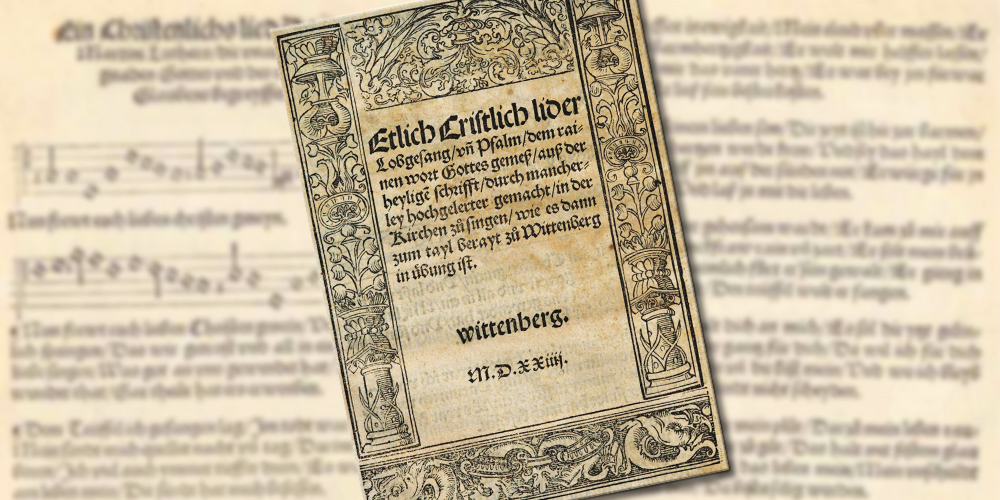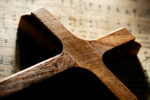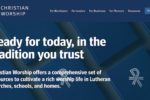 |
History winnows the hymns we sing, with half of the hymns from the first Lutheran hymnal still being sung today.
Of all the hymns that are printed in hymnals, some live long and productive lives, and others don’t. It’s the nature of the beast. For five hundred years, Lutherans have assembled and curated collections of hymns they felt had quality texts and fitting music. Some of those earliest Lutheran hymns are still being sung in Lutheran churches today. Others are not.
In this 500th anniversary of the first Lutheran hymnal, the Achtliederbuch (book of eight songs), the same phenomenon can still be observed—hymns live, and hymns die. It’s how we’ve come to have the hymn collections we have today.
Background
In 2011, Pastor Paul Prange was mindful of the fact that our church body would soon be considering a new hymnal project. Prange also had the Achtliederbuch anniversary in mind when he proposed that our new hymnal be completed by the 500th anniversary of the first Lutheran hymnal. Thus it was that Christian Worship (2021) was slated to be completed by or before 2023/24.
Some things were definitely different in 1523/24. Most notably, copyright restrictions were nonexistent. So when Jobst Gutknecht was able to assemble several broadsheets of recent, popular Lutheran hymnody, he did not need to secure permission to reprint them. Four hymns by Martin Luther, three by Paul Speratus, and one anonymous hymn were laid out in booklet form and given one of the longest hymnal titles you will ever see: Several Christian Songs, Hymns of Praise and Psalms, in Accordance with the Pure Word of God, from Holy Scripture, Produced by Various Highly Learned Individuals, for Singing in the Church, as in Part Is Already the Practice in Wittenberg. Gutknecht may not have held a degree in marketing, but he was shrewd enough to know that mentioning Luther’s home base of Wittenberg in the title would certainly boost sales of a booklet he was actually producing in his shop in Nuremberg.
Other things were very much the same in 1523/24. Not every hymn in a hymnal turns out to be a home run. The eight songs in the first Lutheran hymnal were as follows (numbers have been added):
- “Dear Christians, One and All, Rejoice” (now Christian Worship [CW] 557)
- “Salvation unto Us Has Come” (now CW 558)
- “In One True God I Trust Alone”
- “Oh, God, Man’s Ruin Is So Broad and Grim”
- “O Lord, Look Down from Heaven, Behold” (now CW 865, entitled “O Lord, Take Pity Once You’ve Seen”)
- “The Mouth of Fools May Well Confess”
- “From Depths of Woe I Cry to Thee” (now CW 650, entitled “From Depths of Woe, Lord God, I Cry”)
- “In Jesus’ Name Begin We Now”
The number of hymns in this list that are in our hymnal today is consistent with what can be seen across current Lutheran hymnals: Three or four (roughly 50 percent) of the original eight hymns are still in use today. Hymns live, and hymns die.
Distinctive features
This first collection of Lutheran hymns was a carefully laid-out product.
- Woodcuts, the oldest form of printmaking, would provide for the “graphic arts” design of the booklet.
- Hymns #2, #3, and #4 were followed by pages of Scripture references, assuring worshipers that the hymns they were singing were firmly grounded in God’s Word.
- Four tunes were printed out for the eight texts, and four of the texts (#2, #5, #6, #7) could all be sung to the same tune (that of #2), allowing worshipers to sing multiple texts after having learned only a single tune. This proved to be temporary in nature, as both #5 and #7 soon had distinctive tunes of their own. In fact, the melody for #7, today known by its tune name AUS TIEFER NOT, was the first hymn tune composed by Luther himself, a masterpiece that also became a Bach cantata. (Bach treated two other tunes in this collection as well.) It was also around this same time (1524/25) that another tune (nicknamed AUS TIEFER NOT II) composed in Strassburg was attached to Luther’s Psalm 130 text (#7). These two tunes are found on facing pages in the new hymnal (CW 650/651) with a translation and a paraphrase (respectively) of Luther’s Psalm 130 text. With this interchangeability, more than half of the texts and tunes of the Achtliederbuch were able to play a game of musical chairs.
Anniversary worthy
For various reasons, hymns live, and hymns die. It may be unfortunate that some fine biblical hymn texts are no longer sung, but it’s also good that some not so fine hymn tunes have been set aside. History winnows the hymns we sing, and the wheat that we have retained from the Achtliederbuch is mighty fine.
- “Dear Christians, One and All, Rejoice” was the first hymn Luther wrote specifically for congregational use. It would be difficult to improve on the way it tells the salvation story.
- “Salvation unto Us Has Come” by Speratus may have no equal in its treatment of the doctrine of justification. This hymn is said to have reduced Luther to tears when he heard it being sung on the street below his window.
- Shortly after it was written, “From Depths of Woe I Cry to Thee” was sung at the funeral of Luther’s friend and patron, Frederick the Wise, in 1525 at the Castle Church in Wittenberg. After Luther died in Eisleben in 1546, the funeral procession that was making its way back to Wittenberg stopped in Halle. This hymn was sung as Luther’s body lay in state in Halle.
Half of the Achtliederbuch hymns are still being sung in our day. That is part of the story of the hymnals from which we sing—one hymnal contributes to the collection of hymns in the next. Roughly two-thirds of the hymns in The Lutheran Hymnal (1941) moved forward into Christian Worship (1993). Roughly two-thirds of the hymns in Christian Worship (1993) moved forward into (2021). The winnowing continues, and Lutheran congregations today will sing many but not all of the hymns in our hymnal.
As we observe yet another 500th anniversary connected to the Reformation, we are blessed to be able to say that another generation of Lutherans has continued what Jobst Gutknecht began in Nuremberg: the publication of hymns that proclaim and exalt Christ our Savior. As with so many different anniversaries, the prayer of Moses in Psalm 90 is also fitting for this anniversary observance: “Establish the work of our hands for us—yes, establish the work of our hands” (v. 17).
Author: Michael Schultz
Volume 111, Number 03
Issue: March 2024







